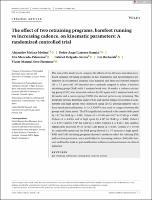Por favor, use este identificador para citar o enlazar este ítem:
https://repositorio.usj.es/handle/123456789/788
| Título : | The effect of two retraining programs, barefoot running vs increasing cadence, on kinematic parameters: A randomized controlled trial |
| Autor: | Molina-Molina, Alejandro



Latorre-Roman, Pedro A. 
Mercado-Palomino, Elia 

Delgado-García, Gabriel 

Richards, Jim 
Soto-Hermoso, Víctor Manuel 

|
| Palabras clave : | Gait retraining; Metronome; Running form; Step rate; Unshod |
| Fecha de publicación: | 28-oct-2021 |
| Editorial : | Wiley |
| Citación : | Molina-Molina A, Latorre-Román PÁ, Mercado-Palomino E, Delgado-García G, Richards J, Soto-Hermoso VM. The effect of two retraining programs, barefoot running vs increasing cadence, on kinematic parameters: A randomized controlled trial. Scand J Med Sci Sports. 2021;00:1–10. https://doi.org/10.1111/sms.14091 |
| Resumen : | The aim of this study was to compare the effects of two 10-week non-laboratory- based running retraining programs on foot kinematics and spatiotemporal parameters in recreational runners. One hundred and three recreational runners (30 +- 7.2 years old, 39% females) were randomly assigned to either: a barefoot retraining group (BAR) with 3 sessions/week over 10 weeks, a cadence retraining group (CAD) who increased cadence by 10% again with 3 sessions/week over 10 weeks and a control group (CON) who did not perform any retraining. The footstrike pattern, footstrike angle (FSA), and spatial-temporal variables at comfortable and high speeds were measured using 2D/3D photogrammetry and a floor-based photocell system. A 3 × 2 ANOVA was used to compare between the groups and 2 time points. The FSA significantly reduced at the comfortable speed by 5.81° for BAR (p < 0.001; Cohen's d = 0.749) and 4.81° for CAD (p = 0.002; Cohen's d = 0.638), and at high speed by 6.54° for BAR (p < 0.001; Cohen's d = 0.753) and by 4.71° for CAD (p = 0.001; Cohen's d = 0.623). The cadence significantly increased by 2% in the CAD group (p = 0.015; Cohen's d = 0.344) at comfortable speed and the BAR group showed a 1.7% increase at high speed. BAR and CAD retraining programs showed a moderate effect for reducing FSA and rearfoot prevalence, and a small effect for increasing cadence. Both offer low-cost and feasible tools for gait modification within recreational runners in clinical scenarios. |
| URI : | https://repositorio.usj.es/handle/123456789/788 |
| ISSN : | 0905-7188 |
| Aparece en las colecciones: | Artículos de revistas |
Ficheros en este ítem:
| Fichero | Descripción | Tamaño | Formato | |
|---|---|---|---|---|
| The effect of two retraining programs, barefoot running.pdf | 687,83 kB | Adobe PDF |  Visualizar/Abrir |
Este ítem está sujeto a una licencia Creative Commons Licencia Creative Commons

